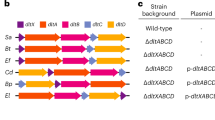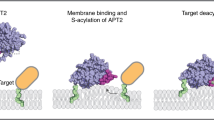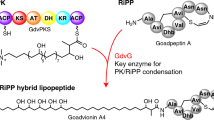Abstract
Acyl carrier protein represents one of the most highly conserved proteins across all domains of life and is nature’s way of transporting hydrocarbon chains in vivo. Notably, type II acyl carrier proteins serve as a crucial interaction hub in primary cellular metabolism1 by communicating transiently between partner enzymes of the numerous biosynthetic pathways2,3. However, the highly transient nature of such interactions and the inherent conformational mobility of acyl carrier protein2 have stymied previous attempts to visualize structurally acyl carrier protein tied to an overall catalytic cycle. This is essential to understanding a fundamental aspect of cellular metabolism leading to compounds that are not only useful to the cell, but also of therapeutic value. For example, acyl carrier protein is central to the biosynthesis of the lipid A (endotoxin) component of lipopolysaccharides in Gram-negative microorganisms, which is required for their growth and survival4,5, and is an activator of the mammalian host’s immune system6,7, thus emerging as an important therapeutic target8,9,10. During lipid A synthesis (Raetz pathway), acyl carrier protein shuttles acyl intermediates linked to its prosthetic 4′-phosphopantetheine group2 among four acyltransferases, including LpxD11. Here we report the crystal structures of three forms of Escherichia coli acyl carrier protein engaging LpxD, which represent stalled substrate and liberated products along the reaction coordinate. The structures show the intricate interactions at the interface that optimally position acyl carrier protein for acyl delivery and that directly involve the pantetheinyl group. Conformational differences among the stalled acyl carrier proteins provide the molecular basis for the association–dissociation process. An unanticipated conformational shift of 4′-phosphopantetheine groups within the LpxD catalytic chamber shows an unprecedented role of acyl carrier protein in product release.
This is a preview of subscription content, access via your institution
Access options
Subscribe to this journal
Receive 51 print issues and online access
$199.00 per year
only $3.90 per issue
Buy this article
- Purchase on Springer Link
- Instant access to full article PDF
Prices may be subject to local taxes which are calculated during checkout




Similar content being viewed by others
References
Butland, G. et al. Interaction network containing conserved and essential protein complexes in Escherichia coli. Nature 433, 531–537 (2005)
Byers, D. M. & Gong, H. Acyl carrier protein: structure-function relationships in a conserved multifunctional protein family. Biochem. Cell Biol. 85, 649–662 (2007)
White, S. W., Zheng, J., Zhang, Y. M. & Rock The structural biology of type II fatty acid biosynthesis. Annu. Rev. Biochem. 74, 791–831 (2005)
Galloway, S. M. & Raetz, C. R. H. A mutant of Escherichia coli defective in the first step of endotoxin biosynthesis. J. Biol. Chem. 265, 6394–6402 (1990)
Belunis, C. J., Clementz, T., Carty, S. M. & Raetz, C. R. H. Inhibition of lipopolysaccharide biosynthesis and cell growth following inactivation of the kdtA gene in Escherichia coli. J. Biol. Chem. 270, 27646–27652 (1995)
Poltorak, A. et al. Defective LPS signaling in C3H/HeJ and C57BL/10ScCr mice: mutations in Tlr4 gene. Science 282, 2085–2088 (1998)
Akira, S., Uematsu, S. & Takeuchi, O. Pathogen recognition and innate immunity. Cell 124, 783–801 (2006)
Onishi, H. R. et al. Antibacterial agents that inhibit lipid A biosynthesis. Science 274, 980–982 (1996)
Williams, A. H., Immormino, R. M., Gewirth, D. T. & Raetz, C. R. H. Structure of UDP-N-acetylglucosamine acyltransferase with a bound antibacterial pentadecapeptide. Proc. Natl Acad. Sci. USA 103, 10877–10882 (2006)
Jenkins, R. J. & Dotson, G. D. Dual targeting antibacterial peptide inhibitor of early lipid A biosynthesis. ACS Chem. Biol. 7, 1170–1177 (2012)
Raetz, C. R. H., Reynolds, C. M., Trent, M. S. & Bishop, R. E. Lipid A modification systems in Gram-negative bacteria. Annu. Rev. Biochem. 76, 295–329 (2007)
Bartling, C. M. & Raetz, C. R. H. Steady-state kinetics and mechanism of LpxD, the N-acyltransferase of lipid A biosynthesis. Biochemistry 47, 5290–5302 (2008)
Leibundgut, M., Jenni, S., Frick, C. & Ban, N. Structural basis for substrate delivery by acyl carrier protein in the yeast fatty acid synthase. Science 316, 288–290 (2007)
Nooren, I. M. & Thornton, J. M. Diversity of protein-protein interactions. EMBO J. 22, 3486–3492 (2003)
Chan, D. I. & Vogel, H. J. Current understanding of fatty acid biosynthesis and the acyl carrier protein. Biochem. J. 430, 1–19 (2010)
Ploskon, E. et al. Recognition of intermediate functionality by acyl carrier protein over a complete cycle of fatty acid biosynthesis. Chem. Biol. 17, 776–785 (2010)
Roujeinikova, A. et al. Structural studies of fatty acyl-(acyl carrier protein) thioesters reveal a hydrophobic binding cavity that can expand to fit longer substrates. J. Mol. Biol. 365, 135–145 (2007)
Buetow, L., Smith, T. K., Dawson, A., Fyffe, S. & Hunter, W. N. Structure and reactivity of LpxD, the N-acyltransferase of lipid A biosynthesis. Proc. Natl Acad. Sci. USA 104, 4321–4326 (2007)
Bartling, C. M. & Raetz, C. R. H. Crystal structure and acyl chain selectivity of Escherichia coli LpxD, the N-acyltransferase of lipid A biosynthesis. Biochemistry 48, 8672–8683 (2009)
Raetz, C. R. H. & Roderick, S. L. A left-handed parallel β helix in the structure of UDP-N-acetylglucosamine acyltransferase. Science 270, 997–1000 (1995)
Frederick, A. F., Kay, L. E. & Prestegard, J. H. Location of divalent ion sites in acyl carrier protein using relaxation perturbed 2D NMR. FEBS Lett. 238, 43–48 (1988)
Cryle, M. J. & Schlichting, I. Structural insights from a P450 carrier protein complex reveal how specificity is achieved in the P450(BioI) ACP complex. Proc. Natl Acad. Sci. USA 105, 15696–15701 (2008)
Parris, K. D. et al. Crystal structures of substrate binding to Bacillus subtilis holo-(acyl carrier protein) synthase reveal a novel trimeric arrangement of molecules resulting in three active sites. Structure 8, 883–895 (2000)
Kraut, D. A., Carroll, K. S. & Herschlag, D. Challenges in enzyme mechanism and energetics. Annu. Rev. Biochem. 72, 517–571 (2003)
Kelly, T. M., Stachula, S. A., Raetz, C. R. & Anderson, M. S. The firA gene of Escherichia coli encodes UDP-3-O-(R-3-hydroxymyristoyl)-glucosamine N-acyltransferase. The third step of endotoxin biosynthesis. J. Biol. Chem. 268, 19866–19874 (1993)
Agarwal, V., Lin, S., Lukk, T., Nair, S. K. & Cronan, J. E. Structure of the enzyme-acyl carrier protein (ACP) substrate gatekeeper complex required for biotin synthesis. Proc. Natl Acad. Sci. USA 109, 17406–17411 (2012)
Babu, M. et al. Structure of a SLC26 anion transporter STAS domain in complex with acyl carrier protein: implications for E. coli YchM in fatty acid metabolism. Structure 18, 1450–1462 (2010)
Holak, T. A., Nilges, M., Prestegard, J. H., Gronenborn, A. M. & Clore, G. M. Three-dimensional structure of acyl carrier protein in solution determined by nuclear magnetic resonance and the combined use of dynamical simulated annealing and distance geometry. Eur. J. Biochem. 175, 9–15 (1988)
Roujeinikova, A. et al. X-ray crystallographic studies on butyryl-ACP reveal flexibility of the structure around a putative acyl chain binding site. Structure 10, 825–835 (2002)
Jiang, Y., Chan, C. H. & Cronan, J. E. The soluble acyl-acyl carrier protein synthetase of Vibrio harveyi B392 is a member of the medium chain acyl-CoA synthetase family. Biochemistry 45, 10008–10019 (2006)
Rock, C. O., Cronan, J. E., Jr & Armitage, I. M. Molecular properties of acyl carrier protein derivatives. J. Biol. Chem. 256, 2669–2674 (1981)
Otwinowski, Z. & Minor, W. Processing of X-ray diffraction data collected in oscillation mode. Methods Enzymol. 276, 307–326 (1997)
Adams, P. D. et al. PHENIX: a comprehensive Python-based system for macromolecular structure solution. Acta Crystallogr. D 66, 213–221 (2010)
McCoy, A. J. et al. Phaser crystallographic software. J. Appl. Cryst. 40, 658–674 (2007)
Qiu, X. & Janson, C. A. Structure of apo acyl carrier protein and a proposal to engineer protein crystallization through metal ions. Acta Crystallogr. D 60, 1545–1554 (2004)
Emsley, P. & Cowtan, K. Coot: model-building tools for molecular graphics. Acta Crystallogr. D 60, 2126–2132 (2004)
Schuttelkopf, A. W. & van Aalten, D. M. PRODRG: a tool for high-throughput crystallography of protein-ligand complexes. Acta Crystallogr. D 60, 1355–1363 (2004)
Brunger, A. T. et al. Crystallography & NMR system: a new software suite for macromolecular structure determination. Acta Crystallogr. D 54, 905–921 (1998)
Winn, M. D. et al. Overview of the CCP4 suite and current developments. Acta Crystallogr. D 67, 235–242 (2011)
Chen, V. B. et al. MolProbity: all-atom structure validation for macromolecular crystallography. Acta Crystallogr. D 66, 12–21 (2010)
DeLano, W. L. The PyMOL Molecular Graphics System v. 1.3r1 (Schrödinger, LLC, New York, New York, 2012)
Stokes, G. B. & Stumpf, P. K. Fat metabolism in higher plants. The nonenzymatic acylation of dithiothreitol by acyl coenzyme A. Arch. Biochem. Biophys. 162, 638–648 (1974)
Acknowledgements
We acknowledge our co-author Christian R. H. Raetz, who shaped the lipid field with his curiosity and efforts, introducing many scientists to the field during his renowned career. We thank R. Brennan and W. Todd Lowther for reviewing the manuscript. Finally, we thank Z. Guan for the help with the mass spectrometry of ACP, H.-S. Chung and other members of Raetz laboratory, as well as J. M. Burg, for discussions. Crystal screening, data collection and data processing were conducted in collaboration with the Duke Macromolecular X-ray Crystallography Shared Resource. Diffraction data were collected remotely at the Southeast Regional Collaborative Access Team 22-BM and 22-ID beamlines at the Advanced Photon Source, Argonne National Laboratory, supported by the US Department of Energy, Office of Science and the Office of Basic Energy Sciences under Contract number W-31-109-Eng-38. This work was supported by National Institutes of Health grants GM-51310 and AI-055588 awarded to C.R.H.R. and P.Z.
Author information
Authors and Affiliations
Contributions
A.M., C.R.H.R. and C.W.P. designed research; A.M. performed all biochemical experiments under the guidance of C.R.H.R., P.Z. and C.W.P.; A.M. performed all protein expression, purification and crystallization; A.M. and C.W.P. contributed to data collection, structure solution and refinement; A.M., C.R.H.R. and C.W.P. analysed and interpreted the structures; A.M. and C.W.P. made the figures and wrote the manuscript; A.M., C.R.H.R., P.Z. and C.W.P. discussed the results and commented on the manuscript.
Corresponding author
Ethics declarations
Competing interests
The authors declare no competing financial interests.
Supplementary information
Supplementary Information
This file contains Supplementary Tables 1-2 and Supplementary Figures 1-13. Additional details about the cloning primers and sequences, crystallographic data statistics, and structural analysis for the ACP-LpxD complexes are given. Also shown are detailed sequence comparisons with orthologs and biochemical evidence for acyl-ACP hydrolysis and the role of ACP in the LpxD reaction mechanism. (PDF 9957 kb)
Supplementary Data
This file contains the Source Data for Supplementary Figure 12. (XLSX 65 kb)
Rights and permissions
About this article
Cite this article
Masoudi, A., Raetz, C., Zhou, P. et al. Chasing acyl carrier protein through a catalytic cycle of lipid A production. Nature 505, 422–426 (2014). https://doi.org/10.1038/nature12679
Received:
Accepted:
Published:
Issue Date:
DOI: https://doi.org/10.1038/nature12679
This article is cited by
-
Comparative transcriptomic analysis provides insights into transcription mechanisms of Vibrio parahaemolyticus T3SS during interaction with HeLa cells
Brazilian Journal of Microbiology (2022)
-
Gating mechanism of elongating β-ketoacyl-ACP synthases
Nature Communications (2020)
-
Structure guided design of an antibacterial peptide that targets UDP-N-acetylglucosamine acyltransferase
Scientific Reports (2019)
-
Discovery of dual-activity small-molecule ligands of Pseudomonas aeruginosa LpxA and LpxD using SPR and X-ray crystallography
Scientific Reports (2019)
-
A two-helix motif positions the lysophosphatidic acid acyltransferase active site for catalysis within the membrane bilayer
Nature Structural & Molecular Biology (2017)
Comments
By submitting a comment you agree to abide by our Terms and Community Guidelines. If you find something abusive or that does not comply with our terms or guidelines please flag it as inappropriate.



